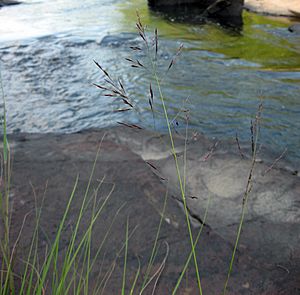Cumberland sandreed facts for kids
Quick facts for kids Cumberland sandreed |
|
|---|---|
 |
|
| Conservation status | |
| Scientific classification | |
| Genus: |
Calamovilfa
|
| Species: |
arcuata
|
| Synonyms | |
|
Sporobolus arcuatus |
|
Calamovilfa arcuata, also known as Cumberland sandreed, is a special type of grass. It is a flowering plant that belongs to the grass family. This unique plant grows naturally in the southeastern United States. You can find it in specific areas along rivers, especially where strong floods happen.
Because it needs such a particular place to grow, Cumberland sandreed is only found in a few spots. These include the Cumberland Plateau and the Ouachita Mountains.
Where Cumberland Sandreed Lives
This grass needs a very specific home. It grows in river habitats that are kept open by powerful floods. These floods happen in rocky rivers with a steep slope. The strong water washes away soil and prevents large trees from growing.
Cumberland sandreed loves these open, prairie-like spaces that floods create. Because its habitat is so special and rare, this grass is considered to be in danger. It doesn't have many populations.
On the Cumberland Plateau, you can often find this grass on sandstone rocks. It sometimes grows alongside two other rare plants. These are Conradina verticillata (Cumberland rosemary) and Solidago arenicola (sand goldenrod). These plants also need this unique river habitat.
Cumberland sandreed produces its flowers in late summer. This timing is helpful because there is less chance of a big flood happening then.
How Cumberland Sandreed Was Named
Scientists first officially described Calamovilfa arcuata in 1970. The first population they studied was found on Daddys Creek in Cumberland County, Tennessee.
Recently, scientists have used genetic tests to learn more about this grass. These tests suggest that Calamovilfa arcuata and other grasses in its group might actually belong to a different genus called Sporobolus. However, this change has not yet been widely accepted by all scientists.


